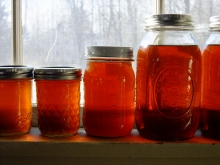You are here
New Research Helps Maple Syrup Producers Predict Season

A new study by Harvard Forest research affiliates Josh Rapp and Elizabeth Crone (Tufts University) used 17 years of data to identify which factors most impact maple syrup production each year. Their answer: autumn seed production.
"Weather affects how much sap will flow out of the tree, but sap volume is only one piece of the puzzle," says Rapp, lead author of the new study, which looked at maple syrup production across 28 sites in Vermont. "Weather alone was a surprisingly bad predictor of how much sugar came out of the taps. There is something else at play."
For several years, Rapp and Crone have been studying "mast" seeding events—years when trees collectively produce far more seeds than usual—at the Harvard Forest.
"Both seeds and sugar are made from carbohydrates stored in trees," explains Crone. "When a tree produces a lot of seeds one summer, then the next spring, the carbohydrate bank account is low for making sugar. It's a matter of budgeting resources."
In sugar maples, mast seeding tends to occur every 2 to 5 years. Recent mast seeding events occurred in Vermont in 2000, 2006, and 2011. Rapp's research shows that in Vermont, syrup production declined following every mast seed year.
Looking ahead to next year's harvest, Rapp notes: "At the Harvard Forest, and likely throughout the northeast, the seed crop was small this year, suggesting the 2015 maple syrup harvest should be a good one."
- Read the full press release and browse photos.
- Read the original scientific paper in Forest Ecology and Management: "Maple Syrup Production Declines Following Masting"
(Photo by Josh Rapp.)

